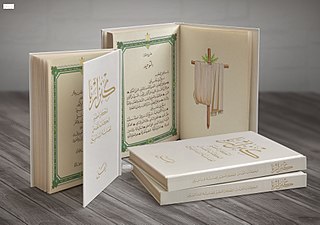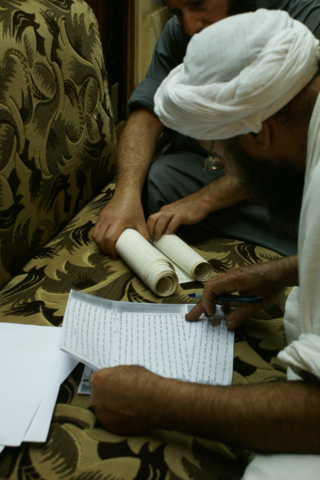
Mandaeism, sometimes also known as Nasoraeanism or Sabianism, is a Gnostic, monotheistic and ethnic religion with Greek, Iranian, and Jewish influences. Its adherents, the Mandaeans, revere Adam, Abel, Seth, Enos, Noah, Shem, Aram, and especially John the Baptist. Mandaeans consider Adam, Seth, Noah, Shem and John the Baptist prophets, with Adam being the founder of the religion and John being the greatest and final prophet.
In Mandaeism, kushta or kušṭa can have several meanings. Its original literal meaning is "truth" in the Mandaic language, and is thus typically used to refer to the Mandaean religious concept of truth. The same word is also used to refer to a sacred handclasp that is used during Mandaean rituals such as the masbuta, masiqta, and priestly initiation ceremonies.

The Qulasta, also spelled Qolastā in older sources, is a compilation of Mandaean prayers. The Mandaic word qolastā means "collection".
Ethel, Lady Drower was a British cultural anthropologist, orientalist and novelist who studied the Middle East and its cultures. She was and is still considered one of the primary specialists on the Mandaeans, and was the dedicated collector of Mandaean manuscripts.
Adam Kasia means "the hidden Adam" in Mandaic. The hidden Adam is also called Adam Qadmaiia. In Mandaeism, it means the soul of the first man. He is also identified as Shishlam, the primordial priest.
The Thousand and Twelve Questions is a Mandaean religious text. The 1012 Questions is one of the most detailed texts on Mandaean priestly rituals. It is kept by Mandaean priests in the shkinta during certain rituals.
The Scroll of Exalted Kingship is a Mandaean religious text. Written as a large illustrated scroll, the text consists of 1363 lines. The scroll is a commentary on the initiation of the tarmida "junior priest".
The Diwan Abatur is a Mandaean religious text. It is a large illustrated scroll that is over 20 ft. long.
Mandaean cosmology is the Gnostic conception of the universe in the religion of Mandaeism.
In Mandaeism, Yushamin and also known as the 'Second Life', is the primal uthra and a subservient emanation who was created by the Mandaean God 'The Great Life', hence beginning the creation of the material world. Yushamin is the father of Abatur. Jorunn J. Buckley identifies Yushamin as "both a Lightworld utra beyond reproach and the prototype of a priest who has made mistakes in ritual."

The masiqta is a mass or ritual practiced in the Mandaean religion in order to help guide the soul (nišimta) towards the World of Light in Mandaean cosmology. They are typically performed as funerary rites for Mandaeans who have just died. Although usually translated as "death mass", a few types of masiqta are also performed for living people, such as when priests are ordained. Masiqtas are also used to consecrate houses of worship.

The Coronation of the Great Šišlam is a Mandaean religious text. The text is a detailed commentary on the initiation of the tarmida, with detailed discussions on masbuta and masiqta rituals. The Scroll of Exalted Kingship is also used extensively alongside the Coronation in tarmida initiation rituals. Similar esoteric texts that are traditionally used exclusively by Mandaean priests include The Thousand and Twelve Questions, and The Baptism of Hibil Ziwa.
Alma Rišaia Zuṭa is a Mandaean religious text. The text is used for Mandaean priestly initiation ceremonies. It is written as a scroll. Alma Rišaia Zuṭa complements Alma Rišaia Rba, or "The Greater Supreme World", a related Mandaic text used for priestly rituals.
Alma Rišaia Rba or Diwan Alma Rišaia Rabbā is a Mandaean religious text. The text is used for Mandaean priestly initiation ceremonies. It is written as a scroll and has numerous illustrations. Alma Rišaia Rba complements Alma Rišaia Zuṭa, or "The Smaller Supreme World", a related Mandaic text used for priestly rituals.
In Mandaeism, Shishlam is a figure representing the prototypical Mandaean priest or Mandaean. He is also frequently referred to in Mandaean texts as Šišlam Rabba (Classical Mandaic: ࡔࡉࡔࡋࡀࡌ ࡓࡁࡀ, romanized: Šišlam Rba, lit. 'Great Shishlam'. Shishlam is sometimes identified with Adam Kasia, the "Perfect Man".
Adam Pagria or Adam Pagra in Mandaeism is the physical body of the primeval man and therefore of all humans. According to Mandaeism, all human bodies can be traced back to this primeval body. In contrast, Adam Kasia is the primeval soul of mankind.

In Mandaean cosmology, Hiṭfun or Hiṭfon (Hiṭpon) is a great dividing river separating the World of Darkness from the World of Light. It is mentioned in Hymn 25 of the third book of the Left Ginza. The river of Hiṭfun is analogous to the river Styx in Greek mythology and Hubur in Mesopotamian mythology.
In Mandaeism, Shdum (Šdum) or Ashdum (Ašdum) is a demon in the World of Darkness or underworld. Hibil Ziwa encounters Shdum during his descent to the World of Darkness in Chapter 1 of Book 5 in the Right Ginza, where he is described as the "King of Darkness" and also as the "Grandson of Darkness".
In Mandaeism, Nbaṭ is an uthra who is described as the "King of Air" or the "first great Radiance." He is also called Nbaṭ Rba or Nbaṭ Ziwa "the Radiant Nbaṭ", literally "Radiance Burst Forth". In The Thousand and Twelve Questions , he is also known as Kušṭa Yaqra "Solemn Truth".






